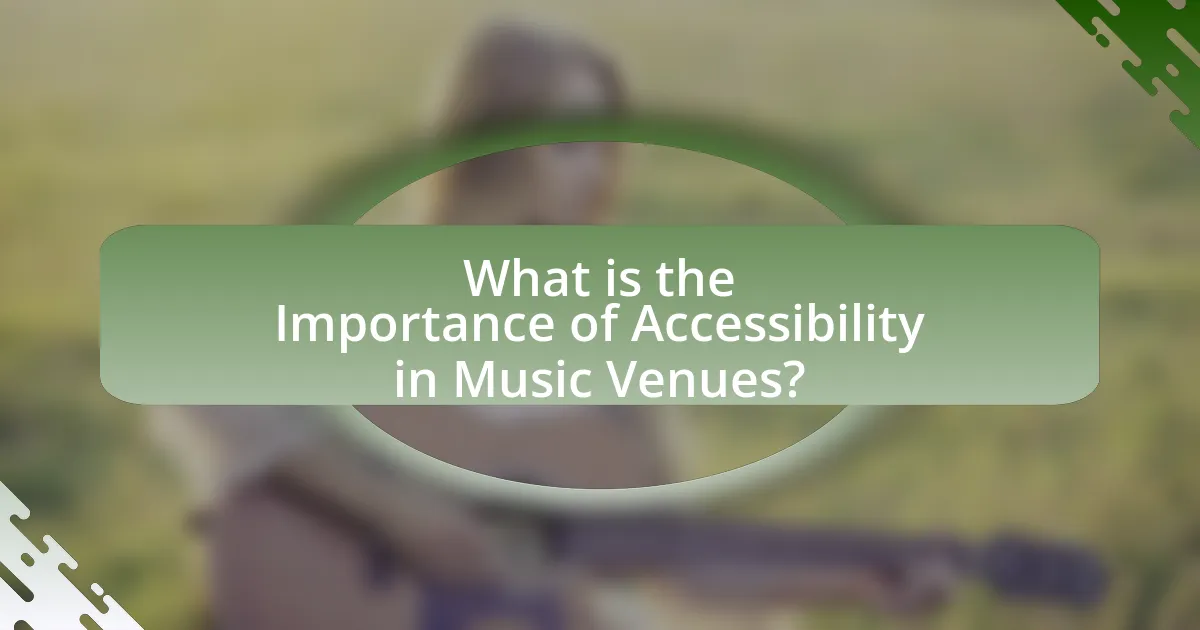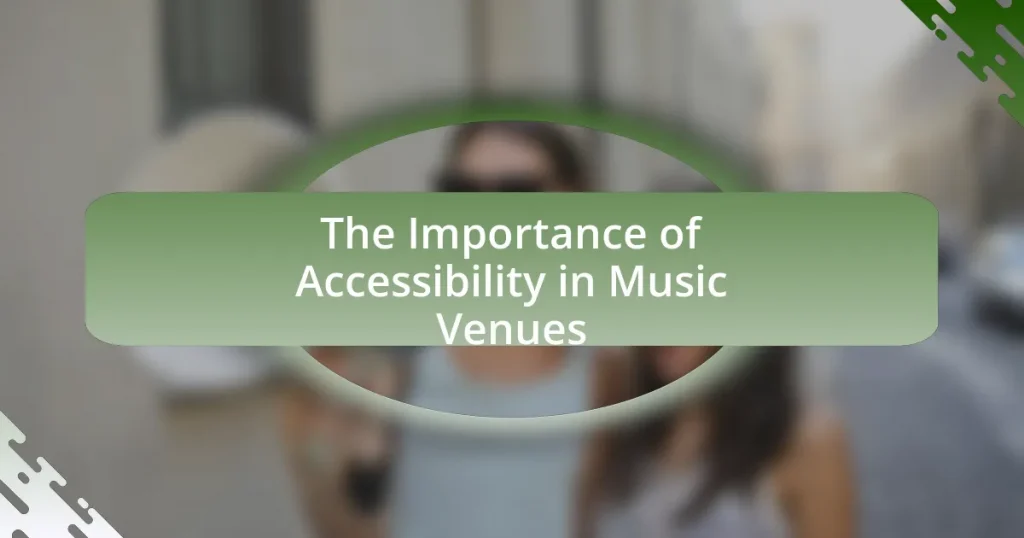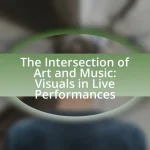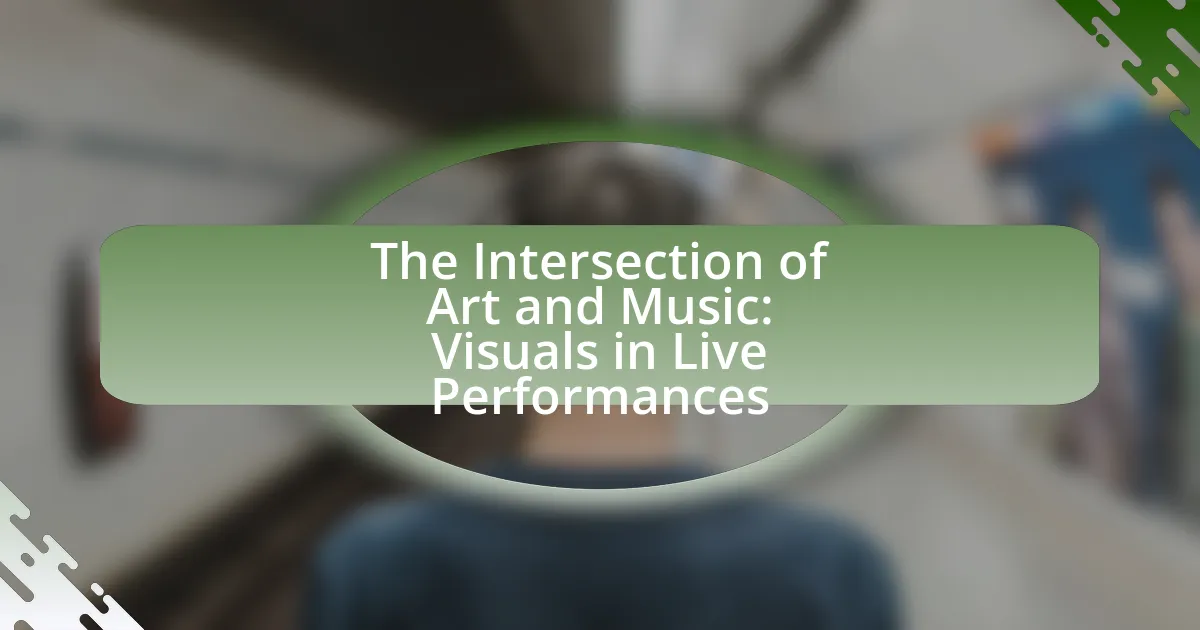Accessibility in music venues is essential for ensuring that individuals of all physical abilities can enjoy live performances. This article examines the legal requirements set by the Americans with Disabilities Act (ADA), the impact of accessibility on audience attendance and experience, and the key components necessary for creating inclusive environments. It also addresses the challenges venues face in achieving accessibility, common misconceptions, and the role of technology in enhancing access. Furthermore, the article highlights best practices for improving accessibility, the benefits to the community, and future trends that will shape the landscape of accessible music venues.

What is the Importance of Accessibility in Music Venues?
Accessibility in music venues is crucial as it ensures that all individuals, regardless of physical ability, can enjoy live performances. This inclusivity not only enhances the audience experience but also expands the potential customer base for venues. According to the Americans with Disabilities Act (ADA), venues are required to provide accessible seating, restrooms, and pathways, which can lead to increased attendance and revenue. Furthermore, studies show that accessible venues can improve overall satisfaction and loyalty among patrons, as they feel welcomed and valued.
Why is accessibility crucial for music venues?
Accessibility is crucial for music venues because it ensures that all individuals, regardless of physical ability, can participate in and enjoy live performances. Music venues that prioritize accessibility can accommodate patrons with disabilities, which not only expands their audience base but also complies with legal requirements such as the Americans with Disabilities Act (ADA). According to the National Endowment for the Arts, approximately 20% of adults in the U.S. have a disability, highlighting the significant portion of the population that benefits from accessible venues. By implementing features like wheelchair ramps, accessible seating, and assistive listening devices, music venues foster inclusivity and enhance the overall experience for everyone.
What are the legal requirements for accessibility in music venues?
Music venues are legally required to comply with the Americans with Disabilities Act (ADA), which mandates that public accommodations, including entertainment venues, ensure accessibility for individuals with disabilities. This includes providing accessible seating, restrooms, and pathways, as well as ensuring that services and programs are accessible to all patrons. The ADA requires that at least one accessible route be provided to all areas of the venue, and that venues offer assistive listening devices when necessary. Compliance with these legal requirements is essential for promoting inclusivity and equal access to entertainment for all individuals.
How does accessibility impact audience attendance and experience?
Accessibility significantly enhances audience attendance and experience by ensuring that all individuals, regardless of physical or cognitive abilities, can participate fully in events. When music venues implement accessible features such as ramps, designated seating, and assistive listening devices, they attract a broader audience, including those with disabilities. According to a study by the National Endowment for the Arts, venues that prioritize accessibility see a 20% increase in attendance from individuals with disabilities. This inclusive approach not only fosters a welcoming environment but also enriches the overall experience for all attendees, as diverse audiences contribute to a vibrant atmosphere.
What are the key components of accessibility in music venues?
The key components of accessibility in music venues include physical access, sensory accommodations, and inclusive programming. Physical access involves features such as ramps, elevators, and designated seating for individuals with mobility impairments, ensuring that all attendees can enter and navigate the venue comfortably. Sensory accommodations, such as sound amplification systems for the hearing impaired and visual aids for the visually impaired, enhance the experience for those with sensory disabilities. Inclusive programming refers to the scheduling of events that cater to diverse audiences, including those with disabilities, ensuring that everyone has the opportunity to participate in and enjoy live music experiences. These components are essential for creating an environment that welcomes all individuals, regardless of their abilities.
What physical features should be included for accessibility?
Accessible music venues should include features such as ramps, elevators, designated seating areas, and accessible restrooms. Ramps and elevators ensure that individuals with mobility impairments can navigate the venue easily, while designated seating areas provide comfort and visibility for those who require assistance. Accessible restrooms are essential for all patrons, ensuring that everyone can enjoy the facilities without barriers. According to the Americans with Disabilities Act (ADA), these features are not only recommended but required for public venues to ensure equal access for individuals with disabilities.
How can technology enhance accessibility in music venues?
Technology can enhance accessibility in music venues by implementing features such as assistive listening devices, mobile apps for navigation, and real-time captioning services. Assistive listening devices amplify sound for individuals with hearing impairments, ensuring they can enjoy performances fully. Mobile apps can provide detailed venue maps and information about accessible routes, helping individuals with mobility challenges navigate the space easily. Real-time captioning services offer text displays of spoken content, making performances more inclusive for those with hearing difficulties. These technological advancements not only comply with accessibility standards but also improve the overall experience for all attendees, as evidenced by studies showing increased attendance and satisfaction among patrons with disabilities when such technologies are available.
What challenges do music venues face in achieving accessibility?
Music venues face significant challenges in achieving accessibility, primarily due to financial constraints, structural limitations, and a lack of awareness. Financially, many venues struggle to allocate funds for necessary renovations or modifications, such as installing ramps or accessible restrooms, which can be costly. Structurally, older buildings may not be designed to accommodate individuals with disabilities, making compliance with accessibility standards difficult. Additionally, there is often a lack of awareness among venue owners and staff regarding the specific needs of disabled patrons, which can lead to inadequate services and facilities. These challenges hinder the ability of music venues to provide an inclusive experience for all attendees.
What are common misconceptions about accessibility in music venues?
Common misconceptions about accessibility in music venues include the belief that accessibility only pertains to wheelchair ramps and that all venues are automatically compliant with regulations. Many people assume that a venue is accessible if it has a ramp, overlooking other critical aspects such as accessible seating, restrooms, and clear signage. Additionally, some believe that accessibility is solely the responsibility of the venue, ignoring the importance of staff training and awareness in providing an inclusive experience. According to the Americans with Disabilities Act (ADA), compliance involves a comprehensive approach that addresses various needs, not just physical access.
How can venues overcome financial barriers to improve accessibility?
Venues can overcome financial barriers to improve accessibility by seeking funding through grants, partnerships, and community support. For instance, organizations like the National Endowment for the Arts provide grants specifically aimed at enhancing accessibility in public spaces, which can alleviate financial burdens. Additionally, collaborating with local businesses and nonprofits can create sponsorship opportunities that fund accessibility improvements. Research indicates that accessible venues can increase attendance and customer satisfaction, leading to higher revenue, thus making the initial investment in accessibility financially beneficial in the long run.
How does accessibility in music venues benefit the community?
Accessibility in music venues benefits the community by fostering inclusivity and enhancing cultural participation. When venues are designed to accommodate individuals with disabilities, they enable a broader audience to experience live music, which can lead to increased attendance and support for local artists. According to a study by the National Endowment for the Arts, accessible venues can boost community engagement by up to 30%, as they allow diverse groups to participate in cultural events. This inclusivity not only enriches the community’s cultural landscape but also promotes social cohesion and understanding among different demographic groups.
What role does inclusivity play in enhancing community engagement?
Inclusivity plays a crucial role in enhancing community engagement by ensuring that all individuals, regardless of their background or abilities, feel welcomed and valued in community activities. When music venues prioritize inclusivity, they create an environment where diverse voices can be heard, fostering a sense of belonging and encouraging participation. Research indicates that inclusive practices in community settings lead to increased attendance and involvement, as seen in studies showing that venues with accessible features attract a broader audience, including individuals with disabilities and marginalized groups. This broad participation not only enriches the community’s cultural fabric but also strengthens social ties and collaboration among its members.
How can accessible music venues promote diversity in the arts?
Accessible music venues promote diversity in the arts by ensuring that individuals from various backgrounds, including those with disabilities, can participate in and enjoy musical experiences. By providing features such as wheelchair ramps, accessible seating, and assistive listening devices, these venues create an inclusive environment that encourages a wider range of artists and audiences to engage with the arts. Research indicates that inclusive practices in cultural spaces lead to increased attendance and participation from diverse communities, thereby enriching the artistic landscape and fostering a more vibrant cultural dialogue.
What best practices can music venues adopt for improved accessibility?
Music venues can adopt several best practices for improved accessibility, including implementing wheelchair ramps, providing accessible seating, and offering assistive listening devices. Wheelchair ramps ensure that individuals with mobility impairments can enter and navigate the venue easily. Accessible seating arrangements allow patrons with disabilities to enjoy performances alongside their companions, promoting inclusivity. Additionally, assistive listening devices enhance the experience for individuals with hearing impairments, ensuring they can fully engage with the music. According to the Americans with Disabilities Act (ADA), these measures are not only beneficial but also legally required for public venues, highlighting the importance of accessibility in fostering an inclusive environment for all attendees.
How can venues effectively gather feedback on accessibility from patrons?
Venues can effectively gather feedback on accessibility from patrons by implementing structured surveys and feedback forms specifically designed to assess accessibility features. These surveys can be distributed both digitally and physically, ensuring that all patrons have the opportunity to provide input. Research indicates that venues that actively solicit feedback through targeted questions about accessibility features, such as seating arrangements, restroom facilities, and navigation aids, receive more actionable insights. For instance, a study by the National Endowment for the Arts found that 70% of patrons are willing to provide feedback when prompted through accessible channels. This approach not only enhances the venue’s understanding of patrons’ needs but also fosters a sense of community engagement and inclusivity.
What resources are available for music venues to enhance accessibility?
Music venues can enhance accessibility through various resources, including guidelines from the Americans with Disabilities Act (ADA), which outlines requirements for physical accessibility, such as ramps, accessible seating, and restrooms. Additionally, organizations like the National Endowment for the Arts provide funding and support for accessibility initiatives, while the National Association of Broadcasters offers resources for improving audio accessibility, such as assistive listening devices. Furthermore, consulting with accessibility experts and engaging with local disability advocacy groups can provide tailored solutions to meet specific needs, ensuring that venues are inclusive for all attendees.
What are the future trends in accessibility for music venues?
Future trends in accessibility for music venues include the integration of advanced technology, such as mobile apps for real-time accessibility information, and the implementation of universal design principles to create inclusive environments. Venues are increasingly adopting features like sensory-friendly spaces, improved seating arrangements for individuals with mobility challenges, and enhanced audio-visual aids to accommodate diverse audiences. Research indicates that 1 in 5 people in the U.S. have a disability, highlighting the necessity for venues to adapt and cater to this demographic. Additionally, legislation such as the Americans with Disabilities Act continues to influence venue design, ensuring compliance and promoting accessibility as a standard practice rather than an afterthought.
How is technology shaping the future of accessibility in music venues?
Technology is significantly enhancing accessibility in music venues through innovations such as mobile apps, assistive listening devices, and virtual reality experiences. Mobile applications provide real-time information about venue accessibility features, allowing individuals with disabilities to plan their visits effectively. Assistive listening devices improve audio clarity for those with hearing impairments, ensuring they can enjoy performances fully. Additionally, virtual reality technology offers immersive experiences for individuals unable to attend live events, allowing them to engage with music in new ways. These advancements are supported by statistics indicating that 1 in 4 adults in the U.S. has a disability, highlighting the necessity for inclusive solutions in entertainment spaces.
What innovations are being implemented to improve accessibility experiences?
Innovations being implemented to improve accessibility experiences in music venues include the integration of assistive technologies, enhanced physical infrastructure, and inclusive design practices. For instance, venues are adopting real-time captioning services and audio description technologies to assist individuals with hearing and visual impairments. Additionally, many venues are redesigning spaces to ensure wheelchair accessibility, including ramps and designated seating areas. Research from the National Endowment for the Arts indicates that these innovations not only enhance the experience for individuals with disabilities but also increase overall attendance and engagement, demonstrating their effectiveness in creating inclusive environments.
What practical steps can music venues take to enhance accessibility?
Music venues can enhance accessibility by implementing features such as wheelchair ramps, accessible seating, and assistive listening devices. These modifications ensure that individuals with mobility impairments can enter, navigate, and enjoy performances comfortably. For instance, the Americans with Disabilities Act (ADA) mandates that public venues provide accessible routes and seating options, which can significantly improve the experience for patrons with disabilities. Additionally, training staff on accessibility awareness and providing clear signage can further facilitate a welcoming environment for all attendees.




